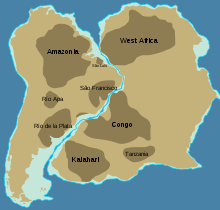The Amazonian Craton is a geologic province located in South America. It occupies a large portion of the central, north and eastern part of the continent and represents one of Earth's largest cratonic regions.[1] The Guiana Shield and Central Brazil Shield (Guaporé Shield) constitute respectively the northern and southern exhumed parts of the craton. Between the two shields lies the Amazon Rift, a zone of weakness within the craton. Smaller cratons of Precambrian rocks south of the Amazonian Shield are the Río de la Plata Craton and the São Francisco Craton, which lies to the east.

The Río Apa Craton at the Paraguay-Brazil border is considered to be likely just the southern part of the Amazonian Craton.[2] The rocks of Río Apa were deformed during the Sunsás orogeny.[3]
It has been suggested that the Late Mesoproterozoic–Early Neoproterozoic aged Sveconorwegian Orogen in Fennoscandia could have been caused by a continent–continent collision between the continents of Amazonia and Baltica.[4] The question is open if Telemarkia terrane in Norway was derived from the Amazonian Craton, but this possibility does not imply necessarily that there was a continental collision.[5]
See also
edit- Geography of Brazil
- Geography of South America
- South American Plate – Major tectonic plate which includes most of South America and a large part of the south Atlantic
References
edit- ^ Bonilla, Amed; Cramer, Thomas; De Grave, Johan; Alessio, Brandon; Glorie, Stijn; Kroonenberg, Salomon (15 July 2021). "The NW Amazonian Craton in Guainía and Vaupés departments, Colombia: Transition between orogenic to anorogenic environments during the Paleo-Mesoproterozoic". Precambrian Research. 360: 106223. doi:10.1016/j.precamres.2021.106223. S2CID 236266292. Retrieved 17 December 2022.
- ^ Mantovani, Marta S.M.; de Brito Neves, Benjamin B. (2010). "The Paranapanema Lithospheric Block: Its Nature and Role in the Accretion of Gondwana". In Gaucher, Claudio; Sial, Alcides; Haverson, Galen (eds.). Neoproterozoic-Cambrian tectonics, global change and evolution: a focus on south western Gondwana. Elsevier. p. 258. doi:10.1016/S0166-2635(09)01619-3.
- ^ Tohver, E.; Trindade, R.I.F.; Solum, G.F.; Hall, C.M.; Riccomini, C.; Nogueira, A.C. (2010). "Closing the Clymene ocean and bending a Brasiliano belt: Evidence for the Cambrian formation of Gondwana, southeast Amazon craton". Geology. 38 (3): 267–270. Bibcode:2010Geo....38..267T. doi:10.1130/G30510.1.
- ^ Slagstad, Trond; Roberts, Nick M. W.; Markens, Rogens; Røhr, Torkil; Schiellerup, Henrik (2013). "A non-collisional, accretionary Sveconorwegian orogen". Terra Nova. 25 (1): 30–37. Bibcode:2013TeNov..25...30S. doi:10.1111/ter.12001. S2CID 129199992.
- ^ Bingen, Bernard; Nordgulen, Øystein; Viola, Giulio (2008). "A four-phase model for the Sveconorwegian orogeny, SW Scandinavia". Norwegian Journal of Geology. 88: 43–72.
Further reading
edit- Zandt, George (Spring 2002). "Orogenic Systems: The Andes". University of Arizona. Archived from the original on 2015-11-09.